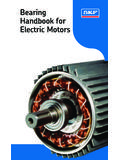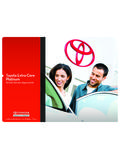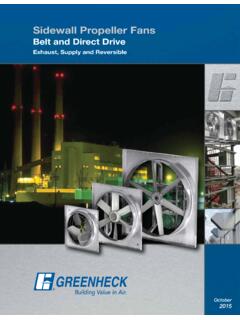Transcription of Chapter 8: Friction - CAU
1 Chapter 8: FrictionSchool of Mechanical Engineering of Dry Friction . Coefficients of of FrictionProblems Involving Dry FrictionSample Problem Problem ScrewsSample Problem Bearings. Axle Bearings. Disk Friction . Rolling Problem Problem of Mechanical Engineering8 -2 IntroductionLaws of Dry Friction . Coefficients of of FrictionProblems Involving Dry FrictionSample Problem Problem ScrewsSample Problem Bearings. Axle Bearings. Disk Friction . Rolling Problem Problem In preceding chapters, it was assumed that surfaces in contact were either frictionless(surfaces could move freely with respect to each other) or rough(tangential forces prevent relative motion between surfaces). Actually, no perfectly frictionless surface exists. For two surfaces in contact, tangential forces, called Friction forces, will develop if one attempts to move one relative to the of Mechanical Engineering8 -3 However, the Friction forces are limited in magnitude and will not prevent motion if sufficiently large forces are applied.
2 The distinction between frictionless and rough is, therefore, a matter of degree. There are two types of Friction : dryor Coulomb frictionand fluid Friction . Fluid Friction applies to lubricated mechanisms. The present discussion is limited to dry Friction between nonlubricated Laws of Dry Friction . Coefficients of Friction Block of weight Wplaced on horizontal surface. Forces acting on block are its weight and reaction of surface N. Small horizontal force Papplied to block. For block to remain stationary, in equilibrium, a horizontal component Fof the surface reaction is required. F is a static- Friction of Mechanical Engineering8 -4 Small horizontal force Papplied to block. For block to remain stationary, in equilibrium, a horizontal component Fof the surface reaction is required. F is a static- Friction force. As Pincreases, the static- Friction force Fincreases as well until it reaches a maximum value Further increase in P causes the block to begin to move as Fdrops to a smaller kinetic- Friction force Laws of Dry Friction .
3 Coefficients of Friction Maximum static- Friction force:NFsmm= Kinetic- Friction @=School of Mechanical Engineering8 -5 Maximum static- Friction force and kinetic- Friction force are:-proportional to normal force-dependent on type and condition of contact surfaces-independent of contact areaThe Laws of Dry Friction . Coefficients of Friction Four situations can occur when a rigid body is in contact with a horizontal surface:School of Mechanical Engineering8 -6 No Friction ,(Px= 0) No motion,(Px< Fm) Motion impending,(Px= Fm) Motion,(Px> Fm)Angles of Friction It is sometimes convenient to replace normal force Nand Friction force Fby their resultant R:School of Mechanical Engineering8 -7 No Friction Motion impending No motionsssmsNNNF mfmf===tantan MotionkkkkkNNNF mfmf===tantanAngles of Friction Consider block of weight Wresting on board with variable inclination angle of Mechanical Engineering8 -8 No Friction No motion Motion impending MotionProblems Involving Dry FrictionSchool of Mechanical Engineering8 -9 All applied forces known Coefficient of static Friction is known Determine whether body will remain at rest or slide All applied forces known Motion is impending Determine value of coefficient of static Friction .
4 Coefficient of static Friction is known Motion is impending Determine magnitude or direction of one of the applied forcesSample Problem : Determine values of Friction force and normal reaction force from plane required to maintain equilibrium. Calculate maximum Friction force and compare with Friction force required for equilibrium. If it is greater, block will not of Mechanical Engineering8 -10A 100 N force acts as shown on a 300 N block placed on an inclined plane. The coefficients of Friction between the block and plane are ms= and mk= Determine whether the block is in equilibrium and find the value of the Friction force. Calculate maximum Friction force and compare with Friction force required for equilibrium. If it is greater, block will not slide. If maximum Friction force is less than Friction force required for equilibrium, block will slide. Calculate kinetic- Friction Problem : Determine values of Friction force and normal reaction force from plane required to maintain equilibrium.
5 :0= xF()0N 300 - N 10053=-FN 80-=F:0= yF()0N 300 - 54=NSchool of Mechanical Engineering8 -11:0= yF()0N 300 - 54=NN 240=N Calculate maximum Friction force and compare with Friction force required for equilibrium. If it is greater, block will not slide.() 240 N 60 NmsmFNFm===The block will slide down the plane. Sample Problem If maximum Friction force is less than Friction force required for equilibrium, block will slide. Calculate kinetic- Friction force.()N 48=actualFSchool of Mechanical Engineering8 -12 Sample Problem : When Wis placed at minimum x, the bracket is about to slip and Friction forces in upper and lower collars are at maximum value. Apply conditions for static equilibrium to find minimum of Mechanical Engineering8 -13 The moveable bracket shown may be placed at any height on the 3-cm diameter pipe. If the coefficient of Friction between the pipe and bracket is , determine the minimum distance xat which the load can be supported. Neglect the weight of the bracket.
6 Apply conditions for static equilibrium to find minimum Problem : When Wis placed at minimum x, the bracket is about to slip and Friction forces in upper and lower collars are at maximum Apply conditions for static equilibrium to find minimum of Mechanical Engineering8 -14 Apply conditions for static equilibrium to find minimum x.:0= xF0=-ABNNABNN=:0= yFWNWNNWFFABABA==-+=-+ :0= BM()()()()()()()() Wedges-simple machines used to raise heavy loads. Force required to lift block is significantly less than block weight. Friction prevents wedge from sliding out. Want to find minimum force Pto raise block. Block as free-body Wedge as free-bodySchool of Mechanical Engineering8 -15 Wedges-simple machines used to raise heavy loads. Force required to lift block is significantly less than block weight. Friction prevents wedge from sliding out. Want to find minimum force Pto raise block. Block as free-body0:00:02121=+--==+-= NNWFNNF sysxmmor021=++WRRvrr()()06sin6cos:006sin 6cos:03232= - +-==+ - --= syssxNNFPNNFmmm Wedge as free-bodyor032=+-RRPrrrSquare-Threaded Screws Square-threaded screws frequently used in jacks, presses, etc.
7 Analysis similar to block on inclined plane. Recall Friction force does not depend on area of contact. Thread of base has been unwrapped and shown as straight line. Slope is 2prhorizontally and lead Lvertically. Moment of force Qis equal to moment of force of Mechanical Engineering8 -16 Impending motion upwards. Solve for Q. Self-locking, solve for Qto lower load. ,qf>s Non-locking, solve for Qto hold load. ,qf>sSample Problem clamp is used to hold two pieces of wood together as shown. The clamp has a double square thread of mean diameter equal to 10 mm with a pitch of 2 mm. The coefficient of Friction between threads is ms = If a maximum torque of 40 N*m is applied in tightening the clamp, determine (a) the force exerted on the pieces of wood, and (b) the torque required to loosen the Calculate lead angle and pitch angle. Using block and plane analogy with impending motion up the plane, calculate the clamping force with a force triangle. With impending motion down the plane, calculate the force and torque required to loosen the of Mechanical Engineering8 -17A clamp is used to hold two pieces of wood together as shown.
8 The clamp has a double square thread of mean diameter equal to 10 mm with a pitch of 2 mm. The coefficient of Friction between threads is ms = If a maximum torque of 40 N*m is applied in tightening the clamp, determine (a) the force exerted on the pieces of wood, and (b) the torque required to loosen the clamp. With impending motion down the plane, calculate the force and torque required to loosen the Problem Calculate lead angle and pitch angle. For the double threaded screw, the lead Lis equal to twice the pitch.() 10mm222tan=====ssrLmfppq = = Using block and plane analogy with impending motion up the plane, calculate clamping force with force of Mechanical Engineering8 -18 Using block and plane analogy with impending motion up the plane, calculate clamping force with force 40mN 40= = =QrQ() ==+ Problem With impending motion down the plane, calculate the force and torque required to loosen the clamp.()() == ()()()() ===rQTorqueSchool of Mechanical Engineering8 -19()()()() === =TorqueJournal Bearings.
9 Axle Friction Journal bearings provide lateral support to rotating shafts. Thrust bearings provide axial support Frictional resistance of fully lubricated bearings depends on clearances, speed and lubricant viscosity. Partially lubricated axles and bearings can be assumed to be in direct contact along a straight line. Forces acting on bearing are weight Wof wheels and shaft, couple Mto maintain motion, and reaction Rof the bearing . School of Mechanical Engineering8 -20 Forces acting on bearing are weight Wof wheels and shaft, couple Mto maintain motion, and reaction Rof the bearing . Reaction is vertical and equal in magnitude to W. Reaction line of action does not pass through shaft center O; Ris located to the right of O, resulting in a moment that is balanced by M. Physically, contact point is displaced as axle climbs in Bearings. Axle FrictionSchool of Mechanical Engineering8 -21 Angle between Rand normal to bearing surface is the angle of kinetic Friction =sin May treat bearing reaction as force-couple system.
10 For graphical solution, Rmust be tangent to circle of =sinThrust Bearings. Disk FrictionConsider rotating hollow shaft:()2122 RRAPrAAPrNrFrMkkk-D=D=D=D=Dpmmm()2122313 232202212221 RRRRP drdrRRPMkRRk--=-= mqpmpSchool of Mechanical Engineering8 -22 For full circle of radius R,PRMkm32=()2122313232202212221 RRRRP drdrRRPMkRRk--=-= mqpmpWheel Friction . Rolling ResistanceSchool of Mechanical Engineering8 -23 Point of wheel in contact with ground has no relative motion with respect to ground. Ideally, no Friction . Moment Mdue to frictional resistance of axle bearing requires couple produced by equal and opposite Pand Friction at rim, wheel would slide. Deformations of wheel and ground cause resultant of ground reaction to be applied at B. Pis required to balance moment of W about Wbb= coef of rolling resistanceSample Problem pulley of diameter can rotate about a fixed shaft of diameter .05 m. The coefficient of static Friction between the pulley and shaft is Determine: the smallest vertical force Prequired to start raising a 500 N load, the smallest vertical force Prequired to hold the load, and the smallest horizontal force P required to start raising the same : With the load on the left and force Pon the right, impending motion is clockwise to raise load.









